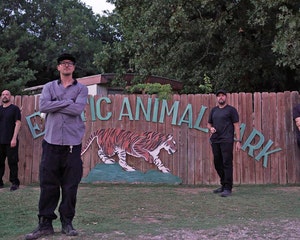 Getty
Getty
Because, 2020.
It's November 24, 2020, which can mean only one thing: America is being invaded by snake-worms and dog-lizards.
Two separate reports have identified a pair of invasive species: one is a snake-sized toxic hammerhead worm, the other is a dog-sized omnivorous lizard that will literally eat just about anything they can fit in their mouths... and they've both been spotted in Georgia.
The shovel-headed garden worm, AKA the hammerhead worm, can grow up to almost a foot in length.
 Facebook (Real estate investment expert and exotic animal breeder Michael Poggi )
Facebook (Real estate investment expert and exotic animal breeder Michael Poggi )
Florida Man Mauled by Black Leopard After Paying $150 for 'Full Contact Experience'
View StoryBut don't worry about the nightmare creature's distinctive hammer-shaped head biting you — it's mouth is located half-way down it's body.
Oh, and it also produces the same neurotoxin as the deadly pufferfish — and scientists aren't even sure why. While it isn't believed to secrete enough tetrodotoxin through its skin to be dangerous to humans, experts advice against picking one up, should the need ever come over you.
Also, don't bother trying to kill it with a knife; like many worms, if you cut it in half you're just going to make two of them.
While they are carnivorous, they primarily feed on other earthworms, although, University of Georgia agriculture expert James Murphy told CNN, they sometimes "prey on other soil dwelling invertebrates" too.
 Getty (Stock Image)
Getty (Stock Image)
Siberian Husky Awaits Trial For Allegedly Murdering Neighbor Cat
View StoryMeanwhile, the Argentine tegu — which has already proliferated widely throughout South Florida — has begun crossing the border into Georgia too.
The reptile, which can grow up to four feet in length, poses a threat to farmers and native species alike, eating any fruit or vegetable grown near the ground, the eggs of ground nesting animals, and even the animals themselves if they'll fit in its mouth.
The voracious lizards are popularly kept as pets, but after escaping or being released, the species has begun spreading in the wild — and per National Geographic, are extremely difficult to control once they've taken hold.
Many threatened or endangered species of turtles, snakes, alligators and crocodiles, which nest on the ground, are especially at risk.
Besides their now-established foothold in Florida, the giant lizards have also been spotted in South Carolina, Alabama, Louisiana, and Texas; if many more are released "there is the potential for a very large population in the wild," expert Amy Yackel Adams told the publication.
 Travel Channel
Travel Channel




















